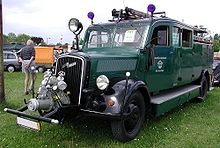Opel factory in Brandenburg
The Opel factory in Brandenburg was built by Adam Opel AG in 1935 on the initiative of the National Socialist government to ensure that the Wehrmacht would be equipped with Opel “Blitz” trucks . Between November 1935 and the destruction of the plant in August 1944, over 130,000 trucks and chassis were manufactured in Brandenburg an der Havel .
history
In early 1935, the Opel press department issued the following announcement:
- “In close contact with key circles in the Reich government, Adam Opel AG decided to build a new factory in Brandenburg an der Havel because the full production capacity in Rüsselsheim has been used. The completion of the building is planned for October 1st, 1935, in order to make room in Rüsselsheim in time for the 1936 program. "
The provided area of 850,000 m² (340 Prussian acres ) on the south bank of the Brandenburger Silokanal (today's (2011) industrial area "Silokanal-Ost") was not fully used, but agriculture could continue to be carried out on large areas.
More about this in the press release:
- "Insofar as this area is not used by the factory or is already planned for further expansion, Adam Opel AG has made it available to the previous owners free of charge until further notice to promote the agricultural production battle."
The groundbreaking ceremony took place on April 7, 1935 and the topping-out ceremony took place on August 10 . The first truck rolled off the assembly line on November 18, 1935 - just 190 days after construction began. The production was located in a single 24,200 m² two-story hall 178 meters long. The body shop and paint shop were located on the ground floor. The chassis, engines and axles were assembled on the upper floor. All 1200 machine tools had individual drives (no transmissions ). A total of 27 conveyor belts with a total length of five kilometers were installed. A separate power plant with a 4000 kW steam turbine supplied energy from 140 quintals of coal per hour.
The total cost of building the plant amounted to 14 million Reichsmarks , which, adjusted for inflation, corresponds to 60 million euros in today's currency. The target was to produce 150 “Blitz” trucks a day . The total capacity of originally 25,000 trucks per year was already significantly exceeded in 1939 with 27,936 units. Hanns Grewenig was the plant manager until October 1938 , then Gerd Stieler von Heydekampf , who was succeeded on July 1, 1942 by the later VW boss Heinrich Nordhoff .
In an Allied air raid on August 6, 1944, half of the factory buildings and 20 percent of the machines were destroyed. At the end of the war it would have been possible to resume production. However, the systems were dismantled on behalf of the victorious powers and taken to the Soviet Union together with the Opel Kadett production facilities in Rüsselsheim as a reparation payment . In contrast to the Kadett production, however, production of the “Blitz” truck was not resumed there.
Employees
(in the language of National Socialism also called " followers / followers")
| year | Employees | Remarks |
|---|---|---|
| 1935 | 680 | Beginning of November |
| 1936 | 1423 | |
| 1940 | 3365 | |
| 1943 | 4286 | Peak |
In 1942, 52 percent of the approximately 4,000 employees at the Brandenburg truck plant were foreign forced laborers.
Production numbers
Between April 1937 and August 1944 , 82,356 trucks with a 3-tonne payload type Blitz “S” (standard) were produced in the Opel factory in Brandenburg . An additional 14,122 units with a long wheelbase and 8,336 versions with a low frame for special bodies (e.g. buses). From July 1940, 24,981 Blitz “A” (all-wheel drive) trucks were added, so that together with the approx. 4,000 half-chain versions of the Blitz “S” ( Sd.Kfz 3a / truck Gleiskette 2 t - “Maultier” ) over 130,000 trucks up to were built for the air raid on the plant in August 1944. The medium-sized off-road standard car (Funkkraftwagen - Kfz. 15 ), developed in 1935/36 according to the specifications of the Heereswaffenamt with independent suspension and all-wheel drive in the Zwickau Horch plant of Auto Union , was licensed from Opel in Brandenburg from 1940 to 1943 only as a chassis without a body produced. The car with engine and all-wheel drive of the Blitz “A” had a payload of 600 kg with an empty weight of 2.7 tons.
literature
- Eckhart Bartels : Opel in the war. Passenger cars - trucks, special constructions (= Das Waffen-Arsenal , vol. 82), Friedberg: Podzun-Pallas-Verlag, 1983, ISBN 978-3-7909-0209-9 and ISBN 3-7909-0209-8
- Hans-Jürgen Schneider: 125 years of Opel, cars and technology. Verlag Schneider + Repschläger, 1987. (without ISBN)
Web links
- The Opel plant in Brandenburg an der Havel (photos and map), on brandenburger-in.de, accessed on May 17, 2020
- Industrial history: Opel factory in Brandenburg ( Memento from February 11, 2017 in the Internet Archive ) on cokebottle-design.de, with old photos
- Hitler American Business Partners (Part 2), GM and Opel during the II. World War II (from 12:03:20) on YouTube , accessed on May 17, 2020
Individual evidence
- ↑ This figure was based on the template: Inflation determined, rounded to one million euros and applies to the previous January
- ↑ Oliver Rathkolb: Forced laborers in industry in: Bernhard Chiari and others: The German war society 1939 to 1945 - exploitation, interpretations, exclusion. on behalf of the MGFA ed. by Jörg Echternkamp , Deutsche Verlags-Anstalt, Stuttgart 2005, Vol. 9/2, ISBN 978-3-421-06528-5 , pp. 679f.
Coordinates: 52 ° 25 ' N , 12 ° 32' E


